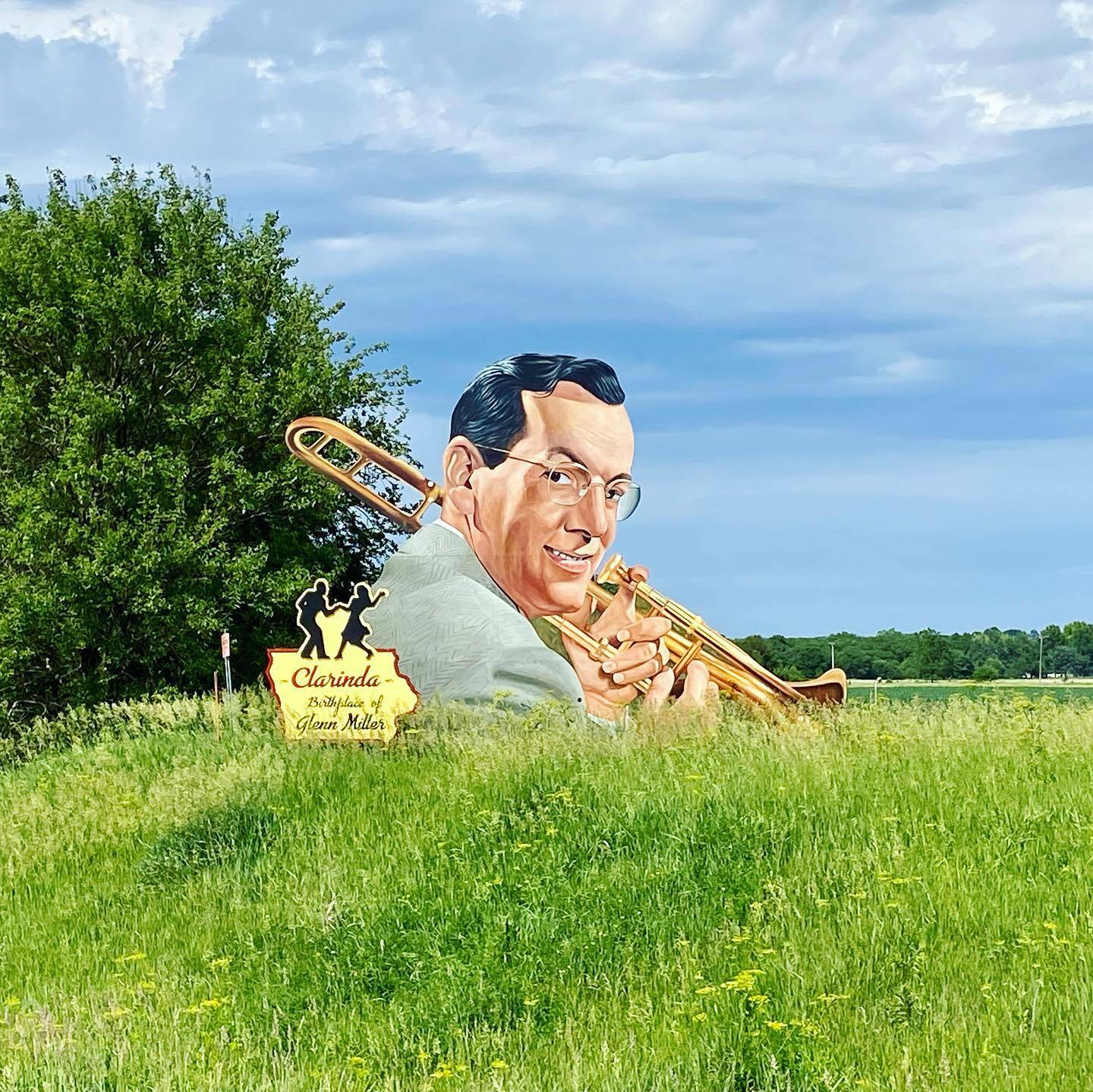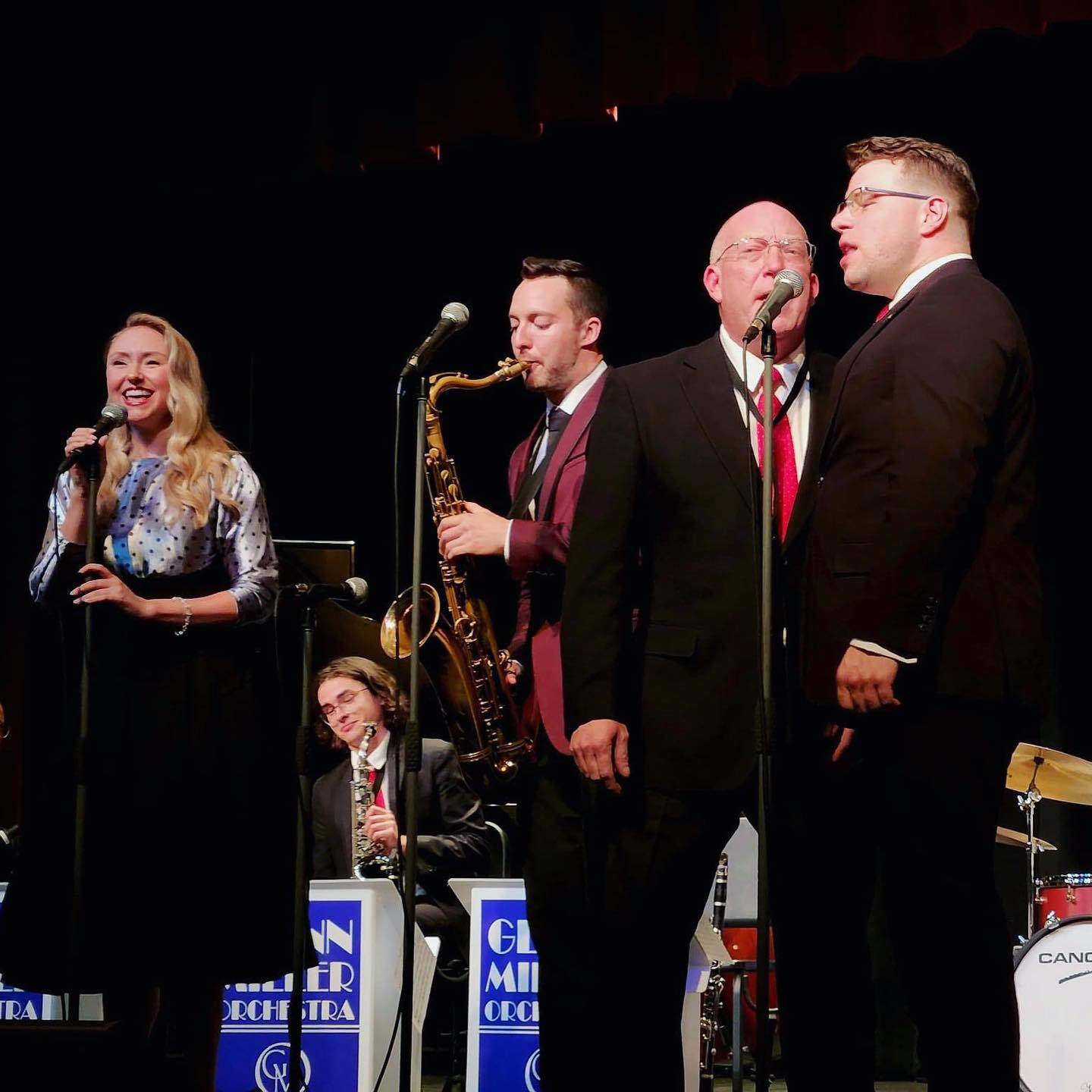
On the second weekend in June I attended for the first time the Glenn Miller Festival in Clarinda, Iowa, his birthplace, an event that has been going on for 45 years. Although the attendance this year numbered in the hundreds, perhaps partly due to a two-year hiatus caused by Covid, the festival reportedly drew thousands of people in prior years. That seems incredible given that Clarinda only has 5,000 residents and probably fewer than 200 hotel rooms. Literally half the town would have had to show up to reach those numbers.
I arrived in the afternoon of Thursday the 9th, so I missed the vocal and instrumental music scholarship competitions that morning. Three winners from each were selected and performed the next morning during a concert by the Glenn Miller Birthplace Society big band, which is comprised mainly of local musicians. They re-created the Chesterfield-sponsored show that the Miller band had three nights a week on CBS radio for several years. But this show lasted about 90 minutes versus the 15 the original band had. One of the vocals was sung by Jan Eberle, the daughter of Glenn’s male singer Ray Eberle. She is evidently a regular attendee.
Following the kick-off picnic in the Clarinda High School cafeteria on Thursday, the 11-piece US Air Force Shades of Blue Band from Scott AFB, Illinois, put on a free concert in the gym. The band is made up of career military personnel and performs around the world supporting the forces that are dispatched from that base. The high school was the site of all events during the festival.
There were several A-V presentations during the festival. One was of Swing Era big bands collected and curated by media historian Mike Delaney from the Chicago area. The videos were enjoyable but there was too much unnecessary conversation while they were playing.
Two much more in-depth presentations occurred Saturday. One was by Dennis Spragg, historian, author and curator of the Miller collection at the University of Colorado. This one, as well as much of the music of the festival, focused on 1942, the last year of Glenn’s civilian band. In fact, at Friday evening’s concert the Miller band played two songs performed but never recorded by Glenn: “Surprisin’ Papa Haydn” and “My Melinda and Me.” A number of people in the audience were clearly very knowledgeable about Miller, which generated very esoteric questions and discussions.
Similarly, an afternoon seminar was led by Loren Schoenberg, senior scholar at the National Jazz Museum in Harlem, and Reinhard Scheer-Hennings, a lawyer in Germany who is also a Miller expert. They discussed the Savory recordings. When I saw that on the program I wondered, “why are they doing a seminar about a spice?”, not recalling that I knew of the broadcast transcriptions made during the ’30s and ’40s by a recording engineer named Bill Savory. These were forgotten until many years later, and Loren, who worked painstakingly to acquire them, is now creating a discography. A majority of the collection is of Benny Goodman, but other bands were also recorded. There are over 1,000 aluminum discs. Savory had also recorded Goodman’s 1938 Carnegie Hall concert. I found this seminar riveting. I knew of Loren but had never met him, until later that day at the Glenn Miller museum. I need to visit the National Jazz Museum on one of my trips to New York.
Naturally, the Glenn Miller Orchestra was on hand, although based on their perpetual touring schedule they might not be an annual fixture. This 16-piece legacy band replicates the original, with four trombones, four trumpets, five reeds, and three rhythm. It’s now led by Erik Stabnau, who also does some vocals. The previous leader for nine years, Nick Hilscher, was here this weekend and was invited to sing several numbers. Their female singer, Jenny Swoish, is, I dare say, better than Marion Hutton from the original band. There is also the Modernaires sequel called the Moonlight Serenaders, drawn from the brass section. The orchestra played a concert Friday evening and a dance Saturday evening. As the dance opened with “Moonlight Serenade,” if I closed my eyes I could almost visualize being at the Glen Island Casino instead of the Clarinda High School gym. Many Miller hits were played. I imagine the band may be tired of playing these tunes at every event, but if you’re selling nostalgia, you have to provide nostalgia.

There were five other ticketed music offerings during the weekend: the St. Joseph (Missouri) Big Band, Gooch (Michael Gurcuillo) and his Las Vegas Big Band, a Saturday breakfast at the town fire hall by the Northwest Missouri State University Jazz Group, an all-request concert by Craig Irvin (about whom an Internet search turned up nothing), and a solo piano concert by Adam Swanson. Adam’s connection to the festival is that he grew up in nearby Shenandoah, Iowa, and appeared here several times while in his teens. I know Adam very well from the ragtime circuit and from having booked him several times at the Tri-State Jazz Society. He is always a great crowd pleaser. As for the other bands, save for Irvin which I did not sign up for, they were competent but their styles were more modern than my tastes.
You may be wondering: how many times were “In the Mood” and “Moonlight Serenade” played during the weekend? Five and four, respectively, by my count. Although I skipped one concert, I know from the request categories provided that neither of these tunes would have been played there.
The festival was scheduled to wrap up Sunday with a free outdoor concert at the museum, but it was cancelled due to an eruption of Covid in the scheduled band, Steve Shininger and the ShinShings Orchestra. In lieu of the Craig Irvin show, I went to the museum. That visit will be the topic of a future column.
My overall impression of the festival, with the perspective of only one visit, is that it is not done on as high a professional level as most other festivals I’ve attended. There was no program booklet containing information about the performers, only a printed schedule of events. There was no questionnaire seeking attendees’ comments about various aspects of the festival. I had not attended before due to the distance from home. I came this year because I could tie it in with the Scott Joplin Ragtime Festival the previous weekend. The two are about 230 miles apart, which gave me an excuse to make a bicycle trip to connect them. Although I have always liked Glenn Miller’s music, this year’s festival and the music it presented concentrated only on his last years, ignoring the considerable role he played earlier on as a member of and arranger for some of the major bands of the time. Many fewer people know of Glenn’s work with Ben Pollack, Benny Goodman, and the Dorsey brothers, and the fact that he put together Ray Noble’s American band that inaugurated the Rainbow Room at Rockefeller Center in 1934.
I’m likely to return occasionally to the Joplin festival, so a future appearance here could happen, too. I just know I will not be connecting the two by bike. I had biked through that area fifteen years ago. The unrelenting hills of northwest Missouri had to have gotten longer and steeper since then, for surely it cannot be that I have gotten older and weaker.
Bill Hoffman is a travel writer, an avid jazz fan and a supporter of musicians keeping traditional jazz alive in performance. He is the concert booker for the Tri-State Jazz Society in greater Philadelphia. Bill lives in Lancaster, PA. He is the author of Going Dutch: A Visitors Guide to the Pennsylvania Dutch Country, Unique and Unusual Places in the Mid-Atlantic Region, and The New York Bicycle Touring Guide. Bill lives in Lancaster, PA.






















